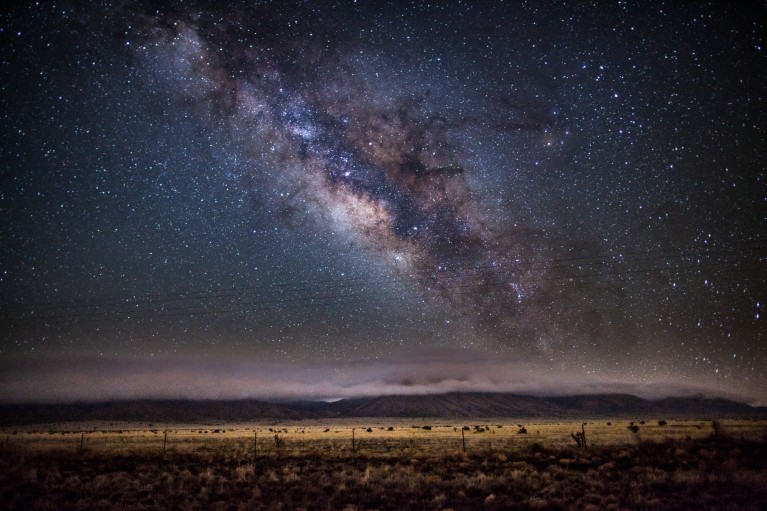Hello Nature readers, would you like to get this Briefing in your inbox free every day? Sign up here.

When we see the Milky Way from Earth, we are looking at the edge of one of its spiral arms.Credit: Getty
Our Galaxy’s core isn’t as densely packed with stars as previously estimated, meaning that the Milky Way is similar to other spiral galaxies with around the same mass. Measuring the Galaxy’s size and shape is tricky — it’s like working out how big a city is while standing on a street corner. Instead of extrapolating from the distribution of stars in our immediate galactic surroundings, scientists measured the locations and distances of almost a quarter of a million massive red giants. These old stars are good markers of visible matter in the Galaxy, and their near-infrared light can pass through the interstellar dust that obscures other wavelengths.
Nature | 4 min read
Reference: Nature Astronomy paper
A single vaccine can protect people from both SARS-CoV-2 and influenza viruses — and with a higher effectiveness than vaccines that target one or the other. Pharmaceutical company Moderna announced the results of its late-stage trials for the mRNA-based vaccine last month, and is now planning to seek approval from the US Food and Drug Administration to bring the vaccine to market. Moderna also hopes to add the respiratory syncytial virus (RSV) to the jab. That means fewer shots — with big potential benefits for public health.
Nature | 4 min read
The US Supreme Court has overturned a longstanding precedent known as the Chevron doctrine — a move seen by some as a blow to evidence-based decision making at US regulatory agencies. Chevron allowed judges to defer to the expertise of agencies when implementing ambiguous federal laws, as long as their interpretations were reasonable. Supporters of Chevron say that it gives expert agencies the flexibility to address new research and challenges — such as innovative technologies, pandemics and climate change — that lawmakers could not have foreseen when they wrote regulatory statutes, often decades ago. But the court has ruled that this gives agencies too much power and that judges should make these decisions themselves.
Science | 5 min read
Read more about Chevron and other issues relevant to the future of science in the US government in Nature’s analysis of a possible second presidential term for Donald Trump. (6 min read, Nature paywall)
Features & opinion
AI algorithms can scour millions of papers, patents and clinical trials to reveal what stops scientists from translating their work into real-world applications, argues innovation researcher Dashun Wang. Data and AI tools could help institutions to identify people and ideas that are overlooked, he says. “If research and development could be made even 5% more efficient, the returns could be immense,” Wang writes.
Nature | 5 min read
Hundreds of studies have tried, and failed, to conclusively show that having a pet improves people’s physical or mental health. One of the difficulties is that pet ownership can’t easily be randomized. Trying to compare people who choose to have pets with those who don’t “actually is a really invalid way of approaching the research question”, says veterinary researcher Kerri Rodriguez. Another issue is that many studies are funded by the pet-care industry.
Undark | 9 min read
What shape, when packed together, wastes the most space? Like many of the most-fun questions in mathematics, it’s simple to ask but fiendishly difficult to answer. When mathematicians Thomas Hales and Koundinya Vajjha took on the problem, they thought they could solve it in six months. Six years later, they say they’ve finally proved that the most unpackable centrally symmetric convex disk is a smoothed polygon. In other words, the most grout-wasting tile shape is a rounded octagon.
Quanta | 8 min read
Reference: arXiv preprint (not peer reviewed)
Image of the week

A cell-laden gel was used to make the ‘skin’ of a grinning robotic face and the ‘ligaments’ that anchor the skin.Credit: M. Kawai et al./Cell Rep. Phys. Sci.
This smiling face is made from living human skin cells anchored to a robotic ‘skeleton’ with ligament-like structures. Attaching living tissue to a mechanical body has proved challenging. This robot’s plastic base contains tiny V-shaped channels that the skin material can grow into. This allows them to perform a similar function to biological ligaments: connecting different layers while retaining flexibility. (Nature Research Highlight | 2 min read, Nature paywall)
Reference: Cell Reports Physical Science paper
Leif Penguinson is taking a break from hiding this week — I look forward to sharing a new penguin puzzle with you again as soon as possible.
While I sit like patience on a monument, smiling at Leif (sorry, Shakespeare!) there is plenty of Tour de France to enjoy. And, as a bonus, a team of geologists is back this year revealing how events —such as that time the Mediterranean Sea dried up for thousands of years —created the landscape necessary for the greatest sporting event in the world.
Help us keep this newsletter at the front of the pack — please send your feedback to briefing@nature.com.
Thanks for reading,
Flora Graham, senior editor, Nature Briefing
With contributions by Katrina Krämer and Smriti Mallapaty
Want more? Sign up to our other free Nature Briefing newsletters:
• Nature Briefing: Microbiology — the most abundant living entities on our planet — microorganisms — and the role they play in health, the environment and food systems.
• Nature Briefing: Anthropocene — climate change, biodiversity, sustainability and geoengineering
• Nature Briefing: AI & Robotics — 100% written by humans, of course
• Nature Briefing: Cancer — a weekly newsletter written with cancer researchers in mind
• Nature Briefing: Translational Research — covers biotechnology, drug discovery and pharma
